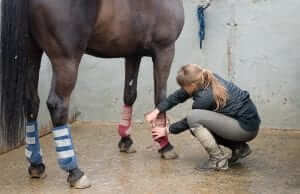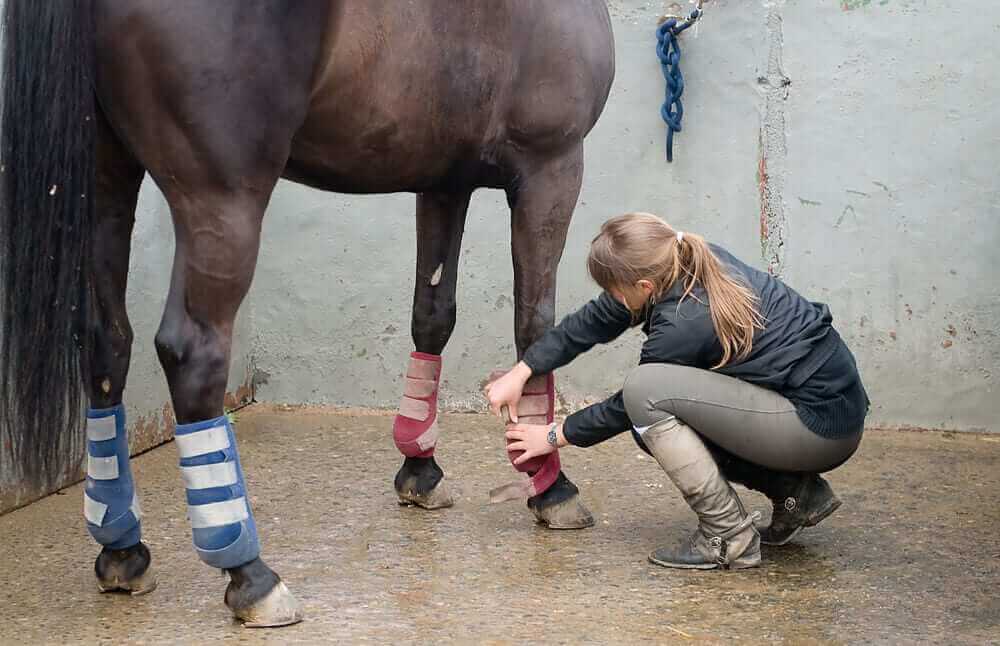A tendon and ligament injury is common in the equine industry, impacting upwards of 30% of horses. Despite the injuries being common, most often result in loss of use or reduced use, especially in highly competitive industries including racing. These injuries are often frustrating to both owner and veterinarian because healing can be slow and often incomplete, despite valiant efforts. Can healing be enhanced and recovery improved? The answer is always an emphatic ‘yes’, but each case can be different.

It is far too common to hear about a horse being sidelined or even retired due to a tendon or ligament injury in the equine industry. One of the most common sites involves the superficial digital flexor tendon (SFDT) while many other horses have injuries of the suspensory ligament. The rate of injuries seems to remain high and many do return to full soundness, competing at the same prior level, while many do not. What is the difference and what other factors are involved?
Many terms are kicked around regarding equine tendon injuries, but they do not always indicate the same thing:(1)
- Tendinopathy is a general term used to reflect or indicate conditions involving tendons but does not indicate any underlying cause or pathology.
- Tendonitis is used to refer to a painful tendon injury, often acute, implying that inflammation is part of the process.
- Tendinosis is used to refer to a painful tendon which is part of a degenerative process and implies an absence of inflammation.
- Tendon Disease refers to repetitive tendon injury usually involved with repetitive loading and impact of ageing on the microscopic damage which accumulates over time.
- Tendon Injury refers to tendon disease but also includes traumatic injury as a cause.
Contributors to a Equine Tendon Injury
There are many different contributors to a equine tendon injury. One of the most common causes of tendon or ligament injuries is overload, essentially implying that the tendon’s capacity to stretch has been exceeded. Now, this is easy to see and in most cases, we often then come to the conclusion that ‘one’ event led to the problem or breakdown. That one jump, that one landing, that one slip in footing. In some cases, this may be true, but in most, it is really a result of accumulating microscopic damage that is occurring over time, which is then weakening that structure. Eventually, after being weakened, that ‘one’ event does lead to breakdown and clinical injury.
Overload is one major contributor, but with that, we have to take into consideration other factors that may accentuate the problem, adding to the overload or to the accumulating microscopic damage.
- Conformation flaws
- Hoof imbalance
- Footing or surface on track or arena
- Protective leg wraps or boots
- Medications
- Diet
- Gastrointestinal health
- Chronic Inflammation
Each of these is a contributor on their own level. We have mechanical overloading, but when we take into consideration these individual factors, we can then see how some are more predisposed. This may then explain why one horse breaks down with a tendon injury, while another does not, on the same surface and general environment.
Let’s look at each one as an individual.
Conformational flaws and Equine Tendon Injury
A conformational flaw is very common and hard to eliminate, even in the best of pedigrees, in the equine industry. No horse is going to be perfect. Abnormalities in conformation are going to put added stress or pressure upon tendon and soft tissue structures, period. Some of the more common problems involve the carpus or knee, hock and lower limbs. There is not much we can do about a horse that is ‘back at the knee’, ‘over at the knee’, or may straight in the hocks. But, if we are aware of the problem, we might be a little more proactive and understanding.
Hoof imbalance and Equine Tendon Injury
Hoof imbalance issues are another very common problem that I encounter as a veterinarian in various equine disciplines. Being viewed along the same lines as a conformation problem, if the foot is out of balance, there will be added stress or pressures to joints and soft tissue structures. This includes too long of a toe, under-run heels, and medial/lateral imbalance. These issues are extremely important not only in tendon injury but in long term injury healing. All too often we have a case of a chronic suspensory or tendon injury that is failing to respond, when actually, the foot balance is improper and continues to add stress. When corrected, the structure then heals more quickly and completely.
Track and Arena Surface Footing and Equine Tendon Injury
The surface footing is another area of hot debate and will vary with the equine discipline. Despite wanting an all inclusive answer to this dilemma, it is not there. Some studies favor soft footing, while in others, harder surfaces appear better. Even with today’s technology and newer surfaces, we have environmental influences such as temperature, which may make that ‘safe’ surface not so safe. Personally, I tend to think that other factors need to be addressed before we get too invested in the surface. After all, we need to look at the wild horses and what surfaces they encounter on a daily basis.
Protective Boots and Wrap to Minimize a Horse Tendon Injury
Protective wraps and boots are also an area of debate. Almost every competitive horse we see, has a boot or wrap of some form on their legs for protection. I think we need to ask, ‘protection against what?’ If we are concerned about over-reaching or interfering from one leg to another and a subsequent wound, then they may be justified. If we are thinking that a wrap or boot may protect against a tendon or ligament strain, we may be misguided. In reality, I think we are misled into thinking that piece of fabric, plastic or bandage material is going to counteract the forces exerted upon a horse’s limb when loaded, especially at high rates. Their use may just make us feel better, that we are doing something ‘proactive’, but could we be doing harm? In some studies, there is tremendous core heat, hyperthermia, produced at a core level within many of those structures during intense exercise. Given this, the application of a boot or wrap could potentially keep this heat contained, instead of allowing it to dissipate. Could this then predispose to an injury? The verdict is currently out, but logic tells us it may not be ideal.
Medications and Impact on Equine Tendon Injury
Medications being administered to a horse is another factor that we don’t take into consideration in many cases. Two of the medications that do concern me are non-steroidal anti-inflammatories (NSAIDs) and proton-pump inhibitors (PPI’s), which are commonly used for ulcer therapy. In the case of tendons and ligaments, inflammation plays a double edged sword type of roll. Too much and we have cellular problems. Too little and we can negatively impact repair mechanisms. When a horse is on a NSAID as part of a therapy program for another problem, i.e., lameness or otherwise, we may be inhibiting that inflammatory process too completely, which may then open the door for tendon or ligament problems. We are all aware of the potential long term effects of NSAIDs, but this may be one we don’t take into consideration. Inflammation is something the body needs and requires, but it should be controlled and balanced. Not inhibited. PPI’s could also create issues due to negative impact on acid production and digestion. In many studies, it is noted that the absorption of many nutrients, including magnesium, is impaired with long term use. Could these medications be impacting tendon and ligament health through this mechanism?
Diet and How it Impacts A Horse Tendon Injury
The horse diet is also a huge component that is often ignored. Tendons and ligaments are living structures, just like any other part of the body, and are dependent on nutrition to maintain strength. They also require full nutritional support in the healing process. Protein is one of the major macronutrients required, but there are also many micronutrients that aid in cellular function. Is the diet being fed sufficient for that particular horse? Is it sufficient for proper cellular repair? The answer can vary from one horse to the next and we should not be misled that the same diet applies to all. We should also not be misled into thinking that the latest vitamin/mineral supplement or hay replacer is going to do the trick. Each horse needs to be evaluated on many levels, determine needs and make sure they are being provided for.
Gastrointestinal Health in the Horse and Impact on Tendon Injury
Gastrointestinal health and digestion is another major component in almost all horses. For some, it is a primary problem, while in others, it becomes secondary. The diet you feed your horse can either directly contribute to a tendon or ligament injury or it can help prevent one and aid in healing. In other articles, we have discussed the concept of ‘leaky gut syndrome‘ and how this can impact digestion, nutrient absorption and even systemic inflammation. Many horses experience this as a first line problem, meaning they have underlying ‘leaky gut’ or digestive issues, which then secondarily weakens structures such as tendons and ligaments. In other horses, we may have a primary overload issue that creates the injury, but then healing is negatively impacted due to secondary gut issues. This would equate to the stall bound horse that develops gastric or hindgut ulcers, acidosis and even leaky gut syndrome all due to stress related causes. When this develops, healing is impaired due to reasons outlined above. This may be further made worse when we add in an anti-ulcer medication.
Chronic Inflammation in the Horse and Impact on the Tendon Health
Chronic inflammation is the final contributor, which actually is interwoven into those mentioned above. This is a broad reaching category, but implies that the horse has ongoing inflammatory issues which are impacting cellular function in a generalized fashion. This then can and does impact tendon and ligament health, either primarily or secondarily. This is also one reason why we talk about systemic inflammation and the need to balance it properly. It is also why in the case of a horse with a stifle, S/I or even foot soreness, the problem is not JUST in that area. The inflammation is all over the horse, in every crevice, not just in that one region we see as the problem. This explains why we often seem to have one problem after another develop in high level equine athletes. Inflammation is discussed further in another article.
As we look over this list, it can be overwhelming, but hopefully we can see that success in healing a tendon or ligament injury is not straight forward in all cases. We can’t just think that an injection or the latest regenerative therapy is going to provide us with the answer. After all, even in the case of stem cells and PRP (platelet rich plasma) therapies, not all horses recover and when many do, it is after 6 months time. Was the recovery due to that therapy or were other contributors addressed, without realization, that made all of the difference?
In a future article, we will take a look at current therapies to assist in tendon and ligament recovery, and utilization of diet and herbs to enhance results.
Author: Tom Schell, D.V.M., CVCH, CHN
Cur-OST Equine Health Products
References:
- Dakin, S. et al. Resolving and inflammatory concept: The importance of inflammation and resolution in tendinopathy. Vet Immunol Immunopath. 2014. 158 (121-27)


